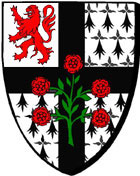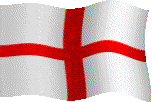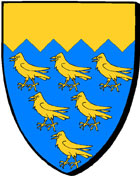
Encyclopédie Marikavel-Jean-Claude-EVEN/Encyclopaedia/Enciclopedia/Enzyklopädie/egkuklopaideia
 |
|||

England Bro-Saoz |
Pevensey
Anderita |

Sussex Bro Saoz ar C'hreisteiz |
| pajenn bet digoret e 2001 | page ouverte en 2001 |
* forum du site Marikavel : Academia Celtica |
dernière mise à jour 11/07/2025 10:46:48 |
![]()
|
Définition / Displegadur : ville d'Angleterre; comté de Sussex; |
|
![]()
|
Histoire / Istor : Le fort britto-romain d'Anderita fait partie du système de défense de la Côte saxonne sur la Manche.
A la fin du IVè siècle, la Notitia Dignitatum nous signale que des unités d'Anderetiani sont cantonnées à : - Vicus Julius / Germersheim : ND XLI-17 : "Praefectus militum Anderetianorum, Uico Iulio". Il s'agit d'une unité d'infanterie. - Paris : ND XLII-22,23 : "Praefectus classis Anderetianorum, Parisius". Il s'agit là d'une unité navale. En contre-partie, Anderita / Pevensey reçoit en garnison une unité Abulcarienne. (cf. Notitia Dignitatum : Praepositus numeri Abulcorum). La fin de la Bretagne britto-romaine fut tragique pour Anderita / Pevensey, comme en témoigne l'extrait suivant de la Chronique anglo-saxonne pour l'anée 491 : "Cette année là, Aelle et Cissa mirent le siège devant Andredescester (le fort romain d'Anderita), Pevensey, et massacrèrent l'ensemble de la population; il ne resta pas un seul Breton vivant en cet endroit". Les Normands construiront par la suite un château fort de type médiéval à l'intérieur même du fort romain. |
![]()
|
Étymologie / Gerdarzh : A1. ALF Rivet & C. Smith, concernant le nom Anderita : ANDERITUM - N.D XXVI -10 : Anderidos, var. Anderitos. - N.D XXVIII -20 : Praepositus numeri Abulcorum, (Anderitos). - Ravenna 10633 : Anderelio. (The tile inscription HON AUG ANDRIA is now known to be spurious) There are further probable records of this name. Stevens in Arch. J., XCVII (1940), 136-37, drawing support from Jullian and Nesselbauf, studies mention in ND VII,100 of the Anderetiani, a unit serving in Gaul. In the MSS they are the Anderenitiani (var. Anderenidani). In the same list, XLI,17, there is mentioned the Praefectus militum Anderetianorum, Uico Iulio [Germersheim] (vars.: Anderecianorum, Andericianorum); and at XLII,22, 23 we find Praefectus classis Anderetianorum, Parisius (with similar vars.). Stevens thought that these Anderetiani, both the milites and the sailors of the naval squadron, 'derive their name from a fort called something like Anderetia', originally Pevensey. This is indeed a likely solution. That proposed by Miller in 1916, that the Anderetiani in Gaul originated at Anderitum Gaballomm (TP, etc.), now Javols (Lozere, France) might suit the soldiers but could not apply to the sailors, for Javols is an entirely inland place. Moreover, on the analogy of other civitates in Gaul, one might expect people of this placc to be known as Gaballi (> Javols), which further removes them from consideration here. The original garrison of the port at Pevensey, the Anderetiani, had evidently been moved to Gaul and replaced in Britain by the numerus Abulcorum. DERIVATION. The first element is *ande-, an intensive prefix conveying 'great, big', on which see Jackson in JRS, XXXVIII (1948), 54, with references to work of Dillon and criticisms of senses ascribed to *ande- by Holder, Zachrisson and Ekwall; also GPN 136-41. The prefix occurs in a good many Continental place-names and some personal names. Anderitum Gaballorum (Javols, mentioned above) is recorded as Anderedon ( = Anderedum) by Ptolemy II, 7,11, Andereton in Ravenna 63,25, and Anderitum in TP. A Colchester dedication (RIB 193) is to Mercurio Deo Andescocivouco, thought by Jackson to mean 'the great activator'. The second element is British *ritu- 'ford', plural *rita (Welsh rhyd, Cornish rid; Irish rith; cognate with Latin portus, English ford, Norwegian fjord, etc.). It is found in the British names Camboritum, Carbantoritum, Durolitum (earlier *Duroritum), Maporitum, Tadoritum), and in many Continental names, of which the best-known is Augustoritum now Limoges (Haute-Vienne, France), but seems to be not known in N. Italy or Spain. These names all show *ritu- singular; see Vincent 225 and 229, GPN 249-51. The same element is present in the modern English names Penrith (Cumbria), Ridware (Staffs.) and Rhydd (Worcs.). Hence, for the present name, a sense 'great ford(s)' is proper, presumably with reference to a crossing of an inlet at Pevensey; the coastline here has changed so much since Roman times that one cannot be specific. The form in which the name should be cited is unsure. Anderida scems to be traditional, but is not likely to be right. Jackson observed that, with respect to a possible -d-,' to the eye of the Celticist the correct form is obviously Romano-British Anderitum or plural Anderita'. The -d- in Ptolemy's form for the corresponding place in Gaul is likely to be casual, and that under ND's pictura of the British name a scribal error. The most likely correction of Ravenna's form is *Andereto. It is not likely that ND's form reflects the Vulgar Latin development (voicing) of t > d, which hardly began in Gaul before A.D. 400, though it might echo the speech of a later copyist on the Continent; and -t- did not lenite in British until the later fifth century, when the name was taken over into Anglo-Saxon with -d- (Andred-: sec below). ND's -s is unexplained. As for the choice between singular *ritu- and plural *rita, it must be noted that all the British and Continental analogues show -ritum, singular, and that the two sources for the name of Pevensey fort show -o-, the usual oblique case for places whose nominative was in -um. Final -a really has no more authority than that engendered by the spurious title with its 'Andria'; philology can discount the inscription just as thermoluminescence dated the material of the tile. On all grounds, then, the proper form for the name is Anderitum. IDENTIFICATION. The Roman fort at Pevensey, Sussex (TQ 6404). Note. The name Anderitum survived for a long time after being taken into Anglo-Saxon. The Anglo-Saxon Chronicle says under A.D. 477 that a Saxon expedition into Sussex slew many Britons 'and drove some to flight into the wood which is called Andredesleag'. This is taken to be the forest which covered the Sussex Weald. An entry in the Chronicle for 491 names the fort itself: 'In this year Aelle and Cissa besieged Andredesceaster and slew all the inhabitants; there was not even one Briton left there.' As a forest-name the usage continued much longer : desertum Ondred in the Life of St Wilfred (about 700); in ASC entries for 755 (Andred, the Hampshire end) and 893 (Andred), and in 1018 Andredesweald; fmally, in the Hampshire Domesday, Andret was applied to part of the New Forest. That the name should have applied so far west is extraordinary, but is confirmed by the ASC for 893: '. .. the mouth of the Lympne. . . that estuary is in east Kent, at the east end of the great forest which wc call Andred. This forest from east to west is 120 miles or longer, and 30 miles broad.' The extension of a fort-name in this way is extraordinary enough, and apparently a unique case; it testifies to the importance of the fort in its region in the third and fourth centuries, perhaps to its continued irnportance at the time of its final capture by the Saxons". ************* Explication Rivet & Smith : " premier élément *ande- = grand, large; second élément : *ritu- = gué, pluriel *rita... Ici, le sens de 'grand' gué est correct, probablement en référence à un passage (baie marécageuse maritime) des environs de Pevensey". ************* - ASC, 491 : Andredeaster; - Vie de St Wilfrid, c. 700 : desertum Ondred; - ASC, 755 : Andred; - ASC, 893 : Andred; - ASC, 1018 : Andredessweald; - Domesday : Andret. |
![]()
|
Extrait de AA Touring map of London and the South East Anderita / Pevensey est marquée du point bleu. La vallée marécageuse maritime est indiquée, à l'arrière de la ville, sous l'appellation Pevensey Levels. Hastings se trouve à 15 km à l'est. Battle, lieu de la victoire de Guillaume le Conquérant, se trouve à 10 km nord-est d'Hastings |
![]()
|
A2. JC Even : Il me semble que la notion de "grand gué, grand passage", est plutôt à mettre en relation avec la traversée de la Manche en cet endroit. Il s'agit en effet d'un passage plus aisé entre le continent et l'Île, quoique plus large, donc d'une durée un peu plus longue, que le passage entre Douvres et Boulogne, plus court, mais plus exposé aux phénomènes des courants marins du détroit. La traversée en sens inverse de Guillaume le Conquérant, en 1066, a abouti à Hastings, précisément située de l'autre côté de la baie marécageuse de Pevensey. Voir à ce sujet l'étude Genèse de la Bretagne armoricaine. concernant le passage de Maxime de l'île de Bretagne vers les Gaules au printemps 383.
***** B. Eilert Ekwall, concernant le nom de Pevensey : Pefenesea, 947 BCS 822; Peueneséa, 1050 ASC (D); Pevensel, DB. Explication : "*Pefen's river. ... the etymology of the person name whose base seems to be Paf-, is obscure". |
![]()
|
Sources; Bibliographie / Eien; Levrlennadur : * Eilert EKWALL : The Concise Oxford Dictionary of English Place-names. Clarendon Press. Oxford. 1960 - 1980 * Dossiers de l'archéologie, n° 37, septembre 1979, chapitre : Les ouvrages de défense du littoral saxon, par Barry CUNLIFFE; page 83-84 * ALF RIVET & Colin SMITH : The Place-names of Roman Britain. Batsford Ltd. 1979 - 1982 - envoi de ** |
![]()
|
Liens électroniques des sites Internet traitant de Pevensey / Anderita : * lien communal : Accueil - Conseil paroissial de Pevensey * autres liens : http://www.forumancientcoins.com/historia/sites/pevensey/pevensey.htm http://bwalker.free.fr/back/anderita.htm http://www.castleuk.net/castle_lists_south/199/pevenseycastle.htm Pevensey - Images et vidéos libres de droits | Adobe Stock * forum du site Marikavel : Academia Celtica * Autres pages de l'encyclopédie Marikavel.org pouvant être liées à la présente : http://marikavel.org/heraldique/bretagne-familles/accueil.htm http://marikavel.org/broceliande/broceliande.htm * solidarité nationale bretonne avec le département de Loire Atlantique : Loire-Atlantique * sauf indication contraire, l'ensemble des blasons figurant sur cette page ont été dessinés par J.C Even, sur bases de GenHerald 5. * Introduction musicale de cette page : Bro Goz Ma Zadoù, hymne national breton, au lien direct : http://limaillet.free.fr/MP3s/BroGoz.mp3 hast buan, ma mignonig, karantez vras am eus evidout go fast, my little friend, I love you very much |
![]()